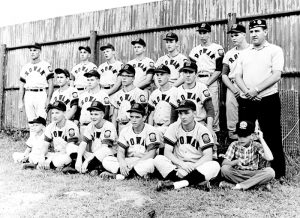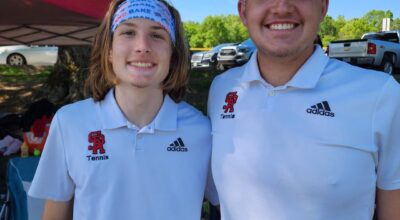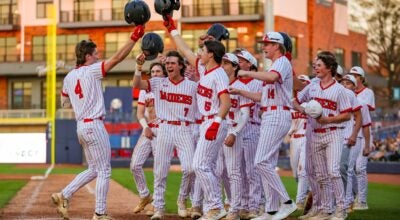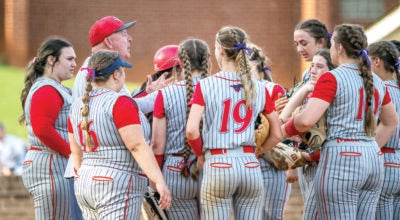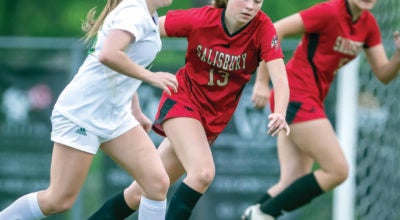Legion baseball: Summer of 1969 was one for the ages
Published 12:15 am Tuesday, August 20, 2019
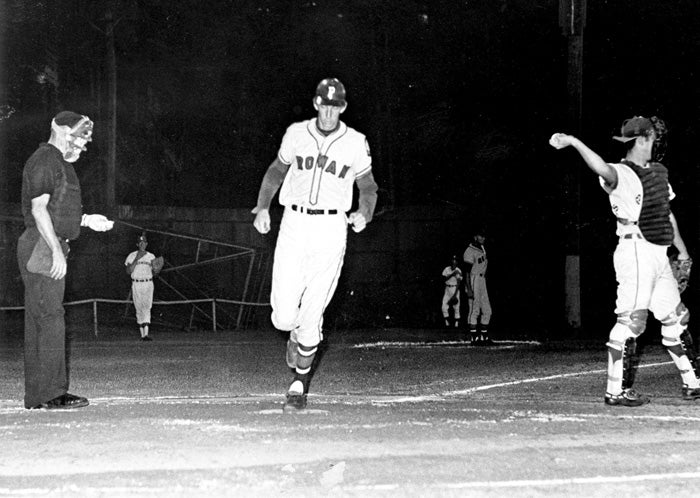
- Salisbury Post file photo ... Rowan County American Legion baseball star Randy Benson crosses home plate during the 1969 state playoffs.
By Mike London
mike.london@salisburypost.com
SALISBURY — They were both picking up their grandchildren from school when Perry Bernhardt and Cass Safrit ran into each other.
“We hadn’t seen each other for 10 or 15 years, but we must have talked for 30 minutes,” Safrit said.
The stories flowed. So did the laughs.
Time moves quickly. Eager young ballplayers turn into grandfathers. It’s been 50 years since Bernhardt, the catcher, and Safrit, the shortstop, played pivotal roles for the 1969 Rowan County American Legion team that won the state championship. As Salisbury Post 14, the program took the state title in 1955 and advanced all the way to the World Series, but 1969 marked the first state crown as “Rowan County.”
The summer of ’69 was a momentous one that included the moon landing, Woodstock, the Amazin’ Mets and numerous iconic moments at Newman Park. Ask any old-timer about Rowan County Legion ball, and the home run Randy Benson lined against Wilmington to decide the state championship would rank near the top of any list of thrills. That homer sent Rowan to Florida for the Southeast Regional, and there are Rowan fans who can still recite announcer Marty Brennaman’s call of Benson’s homer — “That ball has suntan lotion splashed all over it.”
While the road would end at 32-9 with disappointment in Florida, the ride to get there was worth it.
It was a much different environment in 1969. Twenty-five of the 41 games Rowan played that summer were playoff or regional games. The opponents were different — Charlotte, Greensboro, Winston-Salem, East Bend. Rowan didn’t play a single game against programs that are today’s rivals — Stanly, Kannapolis, Mocksville, Mooresville and Concord.
The common denominator for the championship teams of 1955 and 1969 was head coach Joe Ferebee, who turned 100 last February.
“He was a straight-up guy who didn’t mess around,” Safrit said. “Not a bad guy at all to play for, but he expected 100 percent all the time. At game time, he expected you to be serious and ready to go. That worked fine because that’s how that group of players was. Everyone understood that if you didn’t produce, you didn’t play.”
Ferebee left the Salisbury program after the 1956 season, but he returned in 1967. Ferebee’s 1968 team finished as state runner-up at Greensboro Burtner and laid the foundation for 1969. Rowan also would be state runner-up in 1970 and would win another state championship in 1971. It was a terrific era for local Legion baseball.
“I played three years (1968-70) and we were in the state championship game all three years,” Bernhardt said. “We had bar-fight guys. Not that we ever got in bar fights, but what I mean is those were guys you could trust, guys who always had your back.”
A number of Rowan’s offensive players from that era — Safrit, Johnny Yarbrough, Barry Curlee and Rick McBride — still hold places in the record books — but pitching often ruled. Metal bats were new and were still working out the kinks.
“We used wood bats because the metal bats out then were just pieces of pipe,” Bernhardt said. “They weren’t explosive like they are now.”
It was the era when Rowan Legion made the transition from wool uniforms to cotton.
“I remember guys joking that we’d won enough games that they finally got us new uniforms,” Bernhardt said. “Those wool uniforms were hot.”
The 1969 Rowan team had a heavy East Rowan flavor, especially the battery, but there were also major contributions from West Rowan and North Rowan. Those three schools had battled tooth and nail in the North Piedmont Conference in 1969, with Safrit’s West team winning the title. Safrit batted .537 during the high school season and earned All-State honors.
“Those were rivalries and we really wanted to beat each other, but there was always respect,” Safrit said. “If they beat you, you tipped your cap, shook their hand, and said we’ll get you next time. We had no trouble playing together on the Legion team. There was a lot of camaraderie. Yes, there were a lot of East guys, but the West and North guys fit right in. We were brothers. We liked each other and hung out with each other off the field.”
Rowan’s pitching staff in 1969 wasn’t deep — basically five arms — but it was good enough for a powerful run. Yarbrough would become a great pitcher in time, but he wasn’t called on to pitch that season.
Rowan got massive mileage out of Benson (11-2, 0.51 ERA), Donnie Bassinger (10-1, 1.32 ERA), Jimmy Paul (4-2), C.M. Yates (5-1, 1.65 ERA) and Paul Link (2-2). Those five had all of the team’s wins and accounted for 40 of 41 mound decisions. No one worried about pitch counts. The 1969 team won with an iron-willed and rubber-armed staff whose innings-pitched numbers now look like typographical errors.
Benson, whose late father, Vern, was a Cincinnati Reds coach in 1969, was drafted by the Chicago Cubs in the 27th round the first week of June. He stuck around.
“There wasn’t much money involved and I knew I wasn’t ready for pro ball physically or mentally,” Benson said. “It wasn’t a hard decision not to sign.”
Benson, 18, was the oldest pitcher in the rotation. Yates, who was 16 and still had many fabulous football games in front of him as East’s quarterback, was the youngest.
Rowan’s pitching staff threw an incredible 32 complete games. If Ferebee handed you the ball, you finished a lot more often than not.
“People talk about Coach Ferebee not using relievers and all the innings the starters pitched,” Bernhardt said. “But, on that team, there weren’t a lot of options.”
Bernhardt was a team leader and unofficial assistant coach, as well as the starting catcher.
“Perry wasn’t the best hitter, but in a lot of ways, he ran that team,” Safrit said. “He was huge in our pitcher’s success.”
The days Rowan didn’t play frequently meant a scouting mission by Ferebee and Bernhardt.
“I’d climb in Coach Ferebee’s station wagon after practice and we’d drive to Lexington or Statesville to watch a team play,” Bernhardt said. “We’d chart pitches and we’d scout hitters. When we played those teams, I’d have a pretty good idea of what pitches to call.”
Benson set the tone for his remarkable season on opening night at Newman Park. He struck out 21 Winston-Salem hitters and walked five. Rowan won 16-0, but there was no mercy rule in those days. Benson pitched nine innings.
Benson still ranks second in program history (to Tom Eaton) in strikeouts. The lefty compiled 186 of his 352 Legion career strikeouts in 1969.
Rowan’s 5-0 start included a 1-0 victory by Bassinger, another southpaw, against Yadkin County.
“I caught Bassinger, as well as Benson, when I was at East, and he was a great pitcher,” Bernhardt said. “I must have caught a dozen no-hitters, counting my college games at Appalachian State. And I was lucky to play for good teams. We went 22-22 my sophomore year at Appalachian, but the rest of the teams I was on had winning records.”
The first adversity of 1969 came when Winston-Salem scored on an error in the bottom of the ninth to beat Benson, 3-2. Benson struck out 15 and walked nine in that one. How many pitches he threw is anyone’s guess, but it had to be astronomical.
There was one crazy game early — a 21-1 loss to Lexington at Newman Park — in which Ferebee took a look at a pitching hopeful. Lexington blasted seven homers in that one, but Rowan recovered quickly and a 20-strikeout game by Benson started a winning streak. Rowan won its last six regular-season game to improve to 13-3 and won the Southern Division of Area III.
“We were a team with a quiet confidence,” Safrit said. “If we got down 3-0 in the first inning, Coach Ferebee didn’t act worried and we weren’t worried. We didn’t have .400 hitters and we didn’t hit a lot of homers, but we could score enough runs to win. We were good at small ball. We could bunt and we ran the bases well. Defensively, we were solid.”
•••
Rowan opened the playoffs against Thomasville. Benson, Bassinger and Yates allowed one earned run between them in a three-game sweep.
Greensboro Cone was next in the Area III semifinals. Curlee put together a fantastic series, driving in 13 runs in another three-game sweep. In Game 2 at War Memorial Stadium, Rowan trailed 3-0 in the ninth when Curlee crushed a grand slam with a 390-foot drive at War Memorial Stadium. Curlee went 5-for-5 in the series finale.
In the Area III championship series, Rowan faced Charlotte Post 9, which had finished as national runner-up in 1964 (losing the championship game to Upland, California and Rollie Fingers) and as national champion in 1965. Post 9 handed Benson his second loss of the season and ended Rowan’s 12-game winning streak in the series opener.
But Rowan responded to that setback with an 18-4 romp in Charlotte. That game swung the series, and Rowan ended it in five games. Benson went the distance as Rowan clobbered Post 9 at Newman Park, 11-3, to finish the series.
In those days, there was no single-site state championship series for Legion. Just a string of best-of-seven playoff series until only one team was left standing.
Rowan’s opponent in the Western championship series was Gastonia. Fans flocked to Newman Park. There were roped-off sections down both foul lines for Standing Room Only. Paid admissions reportedly often topped 3,000.
It was a six-game series, hard-fought, mostly low-scoring. Rowan hurlers fired three shutouts in that series. Benson struck out 16 to win the opener and tossed a one-hitter with 18 strikeouts to dominate critical Game 5 when the series was tied at two games apiece.
“A key to the pitching staff was Bernhardt,” Benson said. “With two strikes on a hitter we could throw a curveball. If it was in the dirt, Perry always blocked it.”
Bassinger won his ninth in a row when he shut out Gastonia in Game 6 to close the series.
“Our pitchers worked on making pitches,” Bernhardt said. “They not only had good stuff, they were smart. If a hitter crowded the plate, we busted them inside. If they stood deep in the box, we threw curveballs. We picked off a lot of people and we threw out people on pitchouts. We didn’t walk many, and if they put it in play quick, someone made a play.”
Rowan’s infield was generally Dale Watson at first base, Yarbrough at second, Kelly Sparger at third base, and Safrit at shortstop. Curlee (center) and McBride (right) were set in the outfield. Paul, Benson and Yates could man an outfield spot when they weren’t pitching.
•••
The state championship series with Wilmington was one for the ages. The first two games were played in Wilmington. Both were memorable.
In Game 1, Benson shut out Wilmington for 12 innings, striking out 16. Safrit finally won it for Rowan with a two-run double off the wall in the 12th against Wilmington star Mule Reynolds.
In Game 2, Wilmington’s Dave Sandlin pitched a no-hitter to even the series. Yates threw a complete game, but he suffered his only loss of the season.
The series shifted to Newman Park for Game 3. Curlee homered, and Bassinger pitched a complete-game victory. There was temptation to bring Benson back for Game 4, but Paul got the ball and pitched a three-hitter, his best game of the season. Rowan led the series three game to one.
Then Benson won Game 5, 2-1, with his arm and bat. That’s the night he socked his famous, walk-off homer — off Sandlin with two outs in the bottom of the ninth. It was his first homer all season.
“The most surprised person in the ballpark was me,” Benson said. “I had no idea it was a homer until I got to second base and saw Coach Ferebee jumping four feet off the ground. On paper, Wilmington was better than us, but we had a great coach and we had great fans. As players, we had a lot of heart and determination.”
Benson’s blast sent Rowan and its roster of 13 players to the Southeast Regional at West Palm Beach, Fla.
In the first game of the regional, Benson shut out Greenwood, the South Carolina champs. It was his sixth shutout that summer. That would be the last Legion game he pitched. In his last 50 innings on the mound, he would allow one earned run.
On Aug. 21, Rowan took on the host team. Matched up with Palm Beach ace Henry “Penny” Holmes, Bassinger was brilliant. It was still 0-0 going to the bottom of the ninth. That’s when Palm Beach scored the winning run on a sacrifice fly to center field. Curlee’s throw home was on target, and Bernhardt applied the tag. But the call was safe.
“We got snookered,” Bernhardt said. “Fifty years later, he’s still out, and there’s no doubt in my mind about that. I fell on the runner and he never touched the plate. They said he slid under me, but he never got there.”
Benson recalled the runner was stomping off toward the dugout when he was called safe. That was telling.
That was a late game, but now Rowan was in the loser’s bracket in the double-elimination tournament and had to be back on the field the next morning at 10 a.m. Rowan didn’t have it and lost, 8-3, to Greenwood. The season was over. Palm Beach went on to win the regional.
As much pain as there was in the those last two games, Rowan’s season was remarkable.
“Baseball wasn’t my life, but it was a part of it,” Safrit said. “Legion baseball gave me great memories.”
Not long ago, Bernhardt and former Rowan pitcher Jack Moore went to visit Ferebee.
“Coach is 100, and he’s been dwindling,” Bernhardt said. “They told me that he wasn’t having a good day and that he probably wouldn’t know me, but I went over to him and said, ‘Hey, Coach I’m Perry Bernhardt.'”
Ferebee responded quickly with “I know who you are, Perry.”
“Fifty years,” Bernhardt said. “But when you did as many things wrong as I did, I guess you’re hard to forget.”
•••
Benson had an incredible college career pitching for Ferebee at Pfeiffer where he had a personal 23-game winning streak. A third-round draft pick by the Baltimore Orioles in 1972, he finished his career in 1980 in Triple-A, playing for his father.
Safrit, Benson and Palm Beach’s ace pitcher Holmes were teammates in pro ball on the 1972 Bluefield Orioles. Safrit played in the minors from 1972-75 and reached Double-A.
Between high school and American Legion, Bassinger had a record of 39-6.
Drafted by the Chicago White Sox, Curlee played a season in the minors in 1970.


